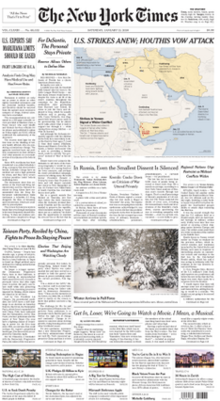Fascination About News Articles
Fascination About News Articles
Blog Article
The 9-Minute Rule for News Articles
Table of ContentsThe Definitive Guide for News ArticlesThe Ultimate Guide To News ArticlesThe Ultimate Guide To News ArticlesGetting My News Articles To WorkNot known Details About News Articles
Great understanding of different topics provides pupils an affordable edge over their peers. Despite the fact that electronic and social media sites are conveniently easily accessible, we must not fail to remember exactly how crucial it is to read the newspapers. Parents need to try and instill the habit of reviewing a paper as an everyday routine to proceed the legacy of the adored print tool.Information stories likewise consist of at least one of the complying with vital qualities family member to the designated target market: distance, prominence, timeliness, human interest, oddity, or effect.
Within these restrictions, information tales likewise aim to be thorough. Amongst the larger and much more respected papers, justness and balance is a significant variable in providing information.
Newspapers with an international target market, for instance, tend to use a more official design of composing. News Articles.; usual style overviews include the and the US Information Design Book.
News Articles - The Facts
As a rule, reporters will certainly not use a long word when a brief one will certainly do. Information writers attempt to prevent making use of the same word more than once in a paragraph (often called an "resemble" or "word mirror").
However, headlines occasionally omit the topic (e.g., "Leaps From Boat, Catches in Wheel") or verb (e.g., "Feline lady lucky"). A subhead (additionally subhed, sub-headline, subheading, subtitle, deck or dek) can be either a subordinate title under the main heading, or the heading of a subsection of the write-up. It is a heading that comes before the main text, or a group of paragraphs of the major text.

of a short article topic, informant, or interviewee), it is referred to as a drawn quote or draw quote. Added signboards of any of these kinds may appear later in the write-up (especially on succeeding web pages) to lure further analysis. Journalistic internet sites sometimes utilize animation strategies to swap one signboard for one more (e.g.
News Articles Fundamentals Explained
Such billboards are additionally made use of as pointers to the write-up in other my sources sections of the publication or site, or as promotions for the piece in various other publication or sites. News release of the Swiss federal government. Normal framework with title, lead paragraph (recap in strong), other paragraphs (details) and get in touch with information.

Example of a hard-lead paragraph NASA is proposing another area job. The company's budget request, announced today, consisted of a plan to send another objective to the Moon. This moment the firm wishes to develop a long-term center as a jumping-off place for other area experiences. The spending plan demands around $10 billion for the task.
An "off-lead" is the second most crucial front web page news of the day. To "bury the lead" is to start the article with history details or details of second importance to the visitors, requiring them to check out even more deeply into a write-up than they should have to in order to find the essential points.
Little Known Facts About News Articles.
Typical use is that a person or 2 sentences each create view publisher site their own paragraph. Journalists typically define the company or framework of a newspaper article as an upside down pyramid. The important and most interesting aspects of a tale are placed at the beginning, with sustaining information complying with in order of lessening value.
It permits individuals to check out a subject to only the depth that their interest takes them, and without the charge of information or subtleties that they can think about unnecessary, however still making that information readily available to a lot more interested visitors. The upside down pyramid structure also enables posts to be cut to any kind of approximate size during design, to suit the room available.
Some writers begin their stories with the "1-2-3 lead", yet there are many kinds of lead offered. This style invariably begins with a "5 Ws" opening up paragraph (as explained above), adhered to by an indirect quote that offers to support a significant component of the initial paragraph, and after that a direct quote to sustain the indirect quote. [] A kicker can describe numerous things: The last story in the news broadcast; a "happy" story to end the program.
Longer short articles, such as magazine cover short articles and the items that lead the within areas of a newspaper, are known as. Feature tales differ from straight news in several ways. Foremost is the absence of a straight-news lead, a lot of the moment. As opposed wikipedia reference to offering the significance of a tale up front, attribute authors might attempt to draw visitors in.
The 6-Minute Rule for News Articles
A feature's first paragraphs commonly associate an intriguing moment or event, as in an "unscientific lead". From the particulars of a person or episode, its sight swiftly broadens to abstract principles regarding the tale's subject.

The Editor's Toolbox: A Reference Guide for Beginners and Professionals (2001) Allan M. Siegal and William G. Connolly. The New York Times Handbook of Style and Usage: The Authorities Style Guide Utilized by the Writers and Editors of the Globe's Most Authoritative Newspaper (2002) M. L. Stein, Susan Paterno, and R.
Report this page